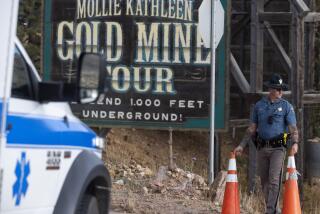Sago Survivor Recalls Miners’ Last Hours
- Share via
MORGANTOWN, W.Va. — As they sat behind a curtain that held back thick smoke but not deadly carbon monoxide, the doomed crew of the Sago Mine talked about the rescue they thought was coming, the sole survivor says.
In a transcript of a June 19 interview with state and federal investigators, Randal McCloy Jr. said he believed a seismographic machine somewhere above them was waiting for a signal from the miners. But they banged on roof bolts in vain: Officials have said such a device was not brought to the mine because it was not needed.
McCloy also added detail to his contention that some of the miners’ air packs didn’t work, something officials who have tested the devices dispute. McCloy said he tried all four of the devices that had failed to work, including one that appeared to have a broken valve.
Twelve men died in the Sago Mine: one in the Jan. 2 blast and the rest hours later of carbon monoxide poisoning. McCloy survived more than 40 hours in poisoned air -- a feat doctors have been unable to explain.
State mine safety officials released the 96-page transcript of McCloy’s two-hour testimony Wednesday. The Associated Press had requested a copy under the Freedom of Information Act.
McCloy, 27, said he had anticipated help from a seismographic machine like the one that had helped save nine men at Pennsylvania’s Quecreek mine after a 78-hour entrapment in 2002.
“I figured they’d bring that machine down and would have found us, would have drilled the hole in the right spot and would have took us out of there,” he said.
“That’s what I expected. I was expecting to hear shots fired on the roof ... and didn’t hear nothing. We banged and banged and banged, everyone did.
“We had a discussion about that, about how long it was going to take. We thought that we was going to get rescued,” he said. “And as time went on, it didn’t look good.”
Federal Mine Safety and Health Administration spokesman Dirk Fillpot said Wednesday that the seismographic equipment was not used because rescuers “were reasonably certain where the miners were located,” and that the machine “is most useful in situations where that is not the case.”
He added that it would have taken 12 to 15 hours to set up the equipment, potentially slowing the rescue effort.
McCloy, who is recovering from brain damage stemming from carbon monoxide exposure, said he didn’t recall whether he’d begun work before the blast occurred, but remembered that the mine filled quickly with smoke and dust that hung in the air, choking the crew.
Foreman Martin “Junior” Toler immediately took charge, calmly organizing his men and telling them to don their self-contained self-rescuers, but Toler’s air pack and three others wouldn’t work, McCloy said. He added that he was among those who shared their oxygen with the four miners.
The men retreated to the face of the mine, hung a cloth barrier and plotted their next move in the light of one headlamp.
After about an hour and a half, McCloy said, Toler and Anderson went to look for a way out. They returned quickly, choking and gagging, turned back by thick smoke and debris.
“All of our options were diminished to nothing,” McCloy said.
More to Read
Sign up for Essential California
The most important California stories and recommendations in your inbox every morning.
You may occasionally receive promotional content from the Los Angeles Times.












